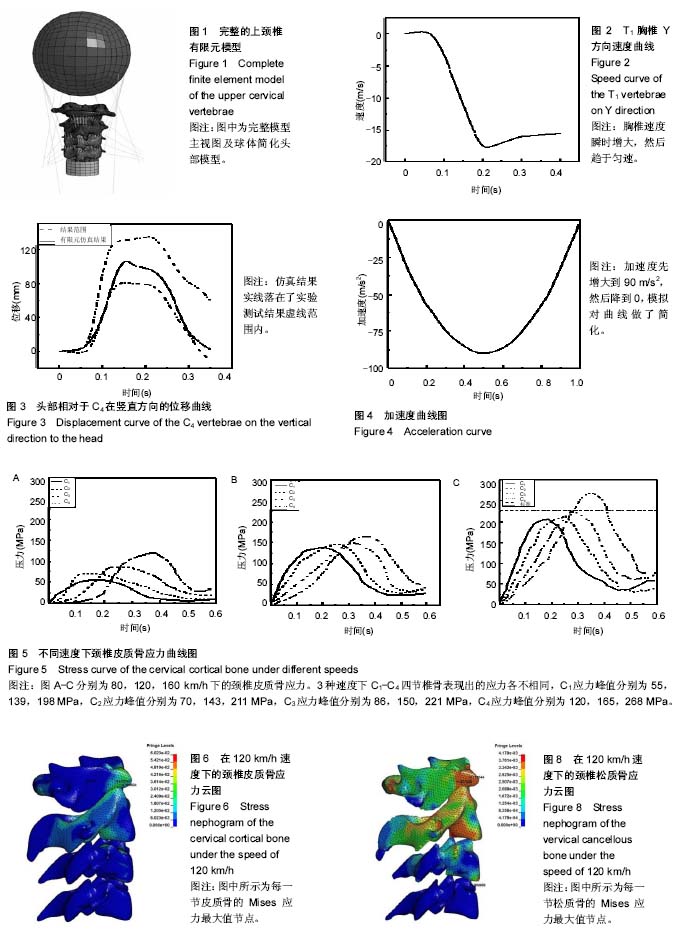| [1] 郭景全. 我国高速公路交通事故现状及特点分析[J]. 黑龙江交通科技, 2015,38(3):184-184.[2] 赵志刚. 高速公路发展现状及前景分析[J]. 交通标准化, 2009, (16):71-73.[3] 高翠,徐丽,葛灵志,等. 高速公路发展面临的困境与对策研究[J]. 公路, 2016,61(10):171-175.[4] 张辽辽. 人体上颈椎建模及汽车高速撞击下颈部损伤研究[D]. 太原理工大学, 2015.[5] 刘敏. 高仿生度人体颈部碰撞分析模型建模及损伤机理研究[D]. 吉林大学, 2016.[6] 李凡,曹迎春,粟思橙,等. 后碰撞中乘员颈部肌肉有限元模型的建立与验证[J]. 湖南大学学报(自科版), 2016, 43(8):45-51.[7] Halldin PH, Brolin K, Kleiven S, et al. Investigation of conditions that affect neck compression-flexion injuries using numerical techniques//Proceedings of the 37th Stapp Car Crash Conference.2000.[8] 许伟. 汽车碰撞事故中乘员头颈部生物力学响应的有限元分析和研究[D]. 湖南大学, 2004.[9] 张镝. 汽车的碰撞与有限元分析法[J]. 黑龙江科技信息, 2016, (5):100-100.[10] 石向明,王辉. 有限元分析在颈椎生物力学研究中的应用[J]. 医学综述, 2012, 18(20):3422-3424.[11] 陈金水,倪斌. 有限元方法在颈椎生物力学研究中的应用进展[J]. 中国矫形外科杂志, 2010, 18(9):739-742.[12] 陈吉清,吴凯,兰凤崇,等. 中国成年男性全颈椎生物力学建模与验证[J]. 汽车工程, 2016,38(11):1305-1311.[13] 张帆,薛强,程大伟,等. 基于颈椎动力学响应的座椅被动安全性研究[J]. 天津科技大学学报, 2016, 31(1):68-72.[14] 王方,肖志,万鑫铭,等. 汽车低速碰撞中的人体颈部响应有限元建模[C]// 2010中国汽车安全技术国际学术会议暨中国汽车工程学会汽车安全技术年会, 2010.[15] 姚剑峰. 人体颈部有限元模型的建立和验证——汽车前碰撞中乘员颈部生物力学响应的分析和研究[D]. 湖南大学, 2002.[16] 柏磊磊,赵改平,王晨曦,等. 基于CT图像下颈椎C4-C6节段三维有限元模型的建立及验证[J]. 生物医学工程学进展, 2015, 36(1):6-11.[17] 王涛,李正东,邵煜,等. 有限元方法在颈椎挥鞭样损伤分析中的应用[J]. 法医学杂志, 2015, 31(1):48-51.[18] Halldin PH, Brolin K, Kleiven S, et al. Investigation of conditions that affect neck compression-flexion injuries using numerical techniques.Proeeedings of the 44th Stapp Car Crash Conferenee,Atlanta Georgia,USA,SAE 2000. 2000-01-sc10.[19] 杨济匡,姚剑锋.人体颈部动力学响应分析有限元模型的建立和验证[J].湖南大学学报,2003,30(4): 40-46.[20] 杨济匡,徐伟,万鑫铭. 研究汽车碰撞中头颈部动态响应的有限元模型的建立和验证[J].湖南大学学报,2005,32(2):6-12.[21] 粟思橙. 基于肌肉主动力的颈部有限元建模研究[D]. 湖南大学, 2014.[22] 王以进,张云然. 头颈部生物力学[M]. 北京:国防工业出版社, 2015.[23] 杨新文,王勇,杨开明. 颈胸段脊柱椎体前方重要结构的解剖特点及其临床意义[J]. 中国临床解剖学杂志, 2009, 27(1):32-34.[24] 希亚特. 头颈解剖学[M]. 中信出版社, 2004.[25] 武强. 颈部临床应用解剖研究及图集制作[D]. 山西医科大学, 2010.[26] Yang KH, Hu J, White NA, et a1.Development of numerical models for injury biomechanics research.a review of 50 years of publications in the Stapp Car Crash Conference. Stapp Car Crash J. 2006;50:429-490. [27] 雷旦,陈吉清,马海立.应用于汽车碰撞安全研究的人体胸部有限元模型的建立与仿真验证[D].华南理工大学,2011.[28] Ewing C,Thomas D,Lustick L,et al. The effect of duration, rate of onset, and peak sled acceleration on the dynamic response of the human head and neck. SAE Paper,No760800:3-41.[29] 杜登云. 人体颈椎建模及车辆后碰撞颈部损伤研究[D]. 吉林大学, 2014.[30] 胡伟. 前碰中颈部肌肉主动力对头颈部动力学响应影响的研究[D]. 湖南大学, 2015.[31] 陈娟. 轿车追尾碰撞对乘员的伤害及改进措施研究[D]. 武汉理工大学, 2013.[32] 田健. 汽车追尾碰撞中儿童颈椎损伤机理的研究[D]. 天津科技大学, 2015.[33] 张帆,薛强,程大伟,等. 基于颈椎动力学响应的座椅被动安全性研究[J]. 天津科技大学学报, 2016, 31(1):68-72.[34] Gatterman ML,加特曼,史亚民. 挥鞭伤:以患者为中心的治疗[M]. 北京:北京大学医学出版社, 2013.[35] 郭瑛,贾连顺. 颈椎飞鞭损伤研究现状与进展[J]. 中国骨伤, 2011, 24(7):613-615.[36] Yang KH, Zhu F, Luan F, et al. Development of a finite element model of the human neck. Proeeedings of the 42nd Stapp Car Crash Conferenee,TemPe,Arizona,USA,SAE 1998: 983157.[37] Matsushita T, Hirabayashi K. X-Ray study of the human neck motion due to head inertia loading. In the 38th Stapp Car Crash Conference. Fort Lauderdale,FL,1994.[38] Davidsson J, Deutscher C, Hell W. Human volunteer kinematics inrear-end sled collsions. IRCOBI 1998,Goteborg.[39] Luan F, Yang KH, Deng B, et al. Qualitative analysis of neck kinematics during low-speed rear-end impact. Clin Biomech. 2000;15:649-657.[40] Szabo TJ, Welcher J. Human subject kinematics and electromyographic activity during low speed rear impacts.In 40th Stapp Car Crash Conference.Albuquerque, NM,1996. |
.jpg)


.jpg)
.jpg)